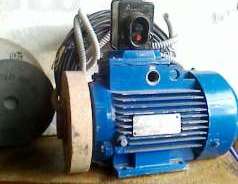Categories: Featured Articles » Sharing experience
Number of views: 41052
Comments on the article: 1
Connecting a three-phase motor to a household network
 The simplest and most widely used method that ensures the operation of a three-phase electric motor from a household network is to connect one of its windings through a phase-shifting capacitor.
The simplest and most widely used method that ensures the operation of a three-phase electric motor from a household network is to connect one of its windings through a phase-shifting capacitor.
The article discusses in detail the issues of calculating engine power and capacitance of a capacitor for various switching schemes.
To calculate the motor power and capacitance of the capacitor, the following data are needed: N - power in kilowatts, I - current in amperes, efficiency.
This data is on the tag of each engine.
Usually, two currents are given on the tag - for the star and for the triangle. You need to take a current for the star. We will extract other data from them: Na = 1000 * N / (3 * efficiency), W - the active power of the winding,
Z = U / I, ohm - impedance of the winding,
U = 220 V - voltage across the windings,
R = Na / I2, ohm - active resistance of the winding. This resistance cannot be measured by a tester and you will not see it when disassembling the engine. In explicit form, it is not. It appears only at work. By performing work, the engine consumes active energy. It is convenient to assume that this energy is released on this resistance.
 ohm
ohm- inductive resistance of the winding. It can only be calculated. DO NOT try to measure it as measured coil inductance. It in a complex way depends on the interaction of the magnetic field of the rotor with the magnetic field of the stator.
Xc is the capacitance in ohms. It is he who we will seek.
C is the capacitance of the capacitor in microfarads. We will find it from the formula C = 3183 / Xc
Nm is the power of a single-phase connection, watts.
For a numerical example, take an engine with such data. N = 3, I = 6.94, U = 220, KPD = 0.819
Connecting the motor according to the star scheme.
I will say right away that the connection according to this scheme is accompanied by the largest loss of power. Yes, only in some engines the "star" is assembled inside thoroughly. We have to put up with this reality. Maximum power is achieved with a tank with resistance -



In our example, Nm = 760.6 watts.
Connection of the engine according to the scheme "torn star 1"
The capacitor is included in the branch with one winding.
Maximum power and corresponding resistance:


Nm = 2,064 watts.
It should be noted that the current in the branch with a capacitor significantly exceeds the nominal. This can be avoided by doubling the resistance. The formulas will take the form:

Nm = 1,500 watts.
As you can see - the power drops noticeably.
Connection of the engine according to the scheme "broken star 2"
The capacitor is included in the branch with two windings. Maximum power and corresponding resistance:


Nm = 1,782 watts
Connecting the engine according to the "triangle".
Maximum power and corresponding resistance:


Nm = 2,228 watts
However, the current in the branch with a capacitor is higher than the nominal. To avoid this, you need to increase the capacitance by one and a half times. Power loss is extremely small.



Nm = 2 185 W.
Fig. 1. Schemes for connecting a three-phase motor to a household network
See also on this topic:Typical schemes for connecting a three-phase motor to a single-phase network
See also at bgv.electricianexp.com
:

